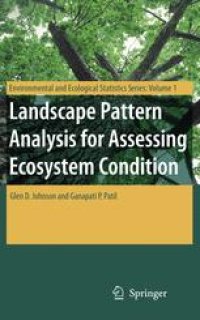
Ebook: Landscape Pattern Analysis for Assessing Ecosystem Condition
- Tags: Landscape Ecology, Remote Sensing/Photogrammetry, Statistics for Life Sciences Medicine Health Sciences, Geographical Information Systems/Cartography, Ecotoxicology, Environmental Monitoring/Analysis
- Series: Environmental and Ecological Statistics 1
- Year: 2007
- Publisher: Springer US
- Edition: 1
- Language: English
- pdf
As we begin the 21st century, one of our greatest challenges is the preservation and remediation of ecosystem integrity. This requires monitoring and assessment over large geographic areas, repeatedly over time, and therefore cannot be practically fulfilled by field measurements alone. Remotely sensed imagery therefore plays a crucial role by its ability to monitor large spatially continuous areas. This technology increasingly provides extensive spatial-temporal data; however, the challenge is to extract meaningful environmental information from such extensive data.
Landscape Pattern Analysis for Assessing Ecosystem Condition presents a new method for assessing spatial pattern in raster land cover maps based on satellite imagery in a way that incorporates multiple pixel resolutions. This is combined with more conventional single-resolution measurements of spatial pattern and simple non-spatial land cover proportions to assess predictability of both surface water quality and ecological integrity within watersheds of the state of Pennsylvania (USA). The efficiency of remote sensing for rapidly assessing large areas is realized through the ability to explain much of the variability of field observations that took several years and many people to obtain.
As we begin the 21st century, one of our greatest challenges is the preservation and remediation of ecosystem integrity. This requires monitoring and assessment over large geographic areas, repeatedly over time, and therefore cannot be practically fulfilled by field measurements alone. Remotely sensed imagery therefore plays a crucial role by its ability to monitor large spatially continuous areas. This technology increasingly provides extensive spatial-temporal data; however, the challenge is to extract meaningful environmental information from such extensive data.
Landscape Pattern Analysis for Assessing Ecosystem Condition presents a new method for assessing spatial pattern in raster land cover maps based on satellite imagery in a way that incorporates multiple pixel resolutions. This is combined with more conventional single-resolution measurements of spatial pattern and simple non-spatial land cover proportions to assess predictability of both surface water quality and ecological integrity within watersheds of the state of Pennsylvania (USA). The efficiency of remote sensing for rapidly assessing large areas is realized through the ability to explain much of the variability of field observations that took several years and many people to obtain.
As we begin the 21st century, one of our greatest challenges is the preservation and remediation of ecosystem integrity. This requires monitoring and assessment over large geographic areas, repeatedly over time, and therefore cannot be practically fulfilled by field measurements alone. Remotely sensed imagery therefore plays a crucial role by its ability to monitor large spatially continuous areas. This technology increasingly provides extensive spatial-temporal data; however, the challenge is to extract meaningful environmental information from such extensive data.
Landscape Pattern Analysis for Assessing Ecosystem Condition presents a new method for assessing spatial pattern in raster land cover maps based on satellite imagery in a way that incorporates multiple pixel resolutions. This is combined with more conventional single-resolution measurements of spatial pattern and simple non-spatial land cover proportions to assess predictability of both surface water quality and ecological integrity within watersheds of the state of Pennsylvania (USA). The efficiency of remote sensing for rapidly assessing large areas is realized through the ability to explain much of the variability of field observations that took several years and many people to obtain.
Content:
Front Matter....Pages i-xvii
Introduction....Pages 1-11
Methods for Quantitative Characterization of Landscape Pattern....Pages 13-22
Illustrations....Pages 23-39
Classifying Pennsylvania Watersheds on the Basis of Landscape Characteristics....Pages 41-56
Predictability of Surface Water Pollution in Pennsylvania Using Watershed-Based Landscape Measurements....Pages 57-78
Predictability of Bird Community-Based Ecological Integrity Using Landscape Variables....Pages 79-108
Summary and Future Directions....Pages 109-114
References....Pages 115-127
Back Matter....Pages 129-130
As we begin the 21st century, one of our greatest challenges is the preservation and remediation of ecosystem integrity. This requires monitoring and assessment over large geographic areas, repeatedly over time, and therefore cannot be practically fulfilled by field measurements alone. Remotely sensed imagery therefore plays a crucial role by its ability to monitor large spatially continuous areas. This technology increasingly provides extensive spatial-temporal data; however, the challenge is to extract meaningful environmental information from such extensive data.
Landscape Pattern Analysis for Assessing Ecosystem Condition presents a new method for assessing spatial pattern in raster land cover maps based on satellite imagery in a way that incorporates multiple pixel resolutions. This is combined with more conventional single-resolution measurements of spatial pattern and simple non-spatial land cover proportions to assess predictability of both surface water quality and ecological integrity within watersheds of the state of Pennsylvania (USA). The efficiency of remote sensing for rapidly assessing large areas is realized through the ability to explain much of the variability of field observations that took several years and many people to obtain.
Content:
Front Matter....Pages i-xvii
Introduction....Pages 1-11
Methods for Quantitative Characterization of Landscape Pattern....Pages 13-22
Illustrations....Pages 23-39
Classifying Pennsylvania Watersheds on the Basis of Landscape Characteristics....Pages 41-56
Predictability of Surface Water Pollution in Pennsylvania Using Watershed-Based Landscape Measurements....Pages 57-78
Predictability of Bird Community-Based Ecological Integrity Using Landscape Variables....Pages 79-108
Summary and Future Directions....Pages 109-114
References....Pages 115-127
Back Matter....Pages 129-130
....